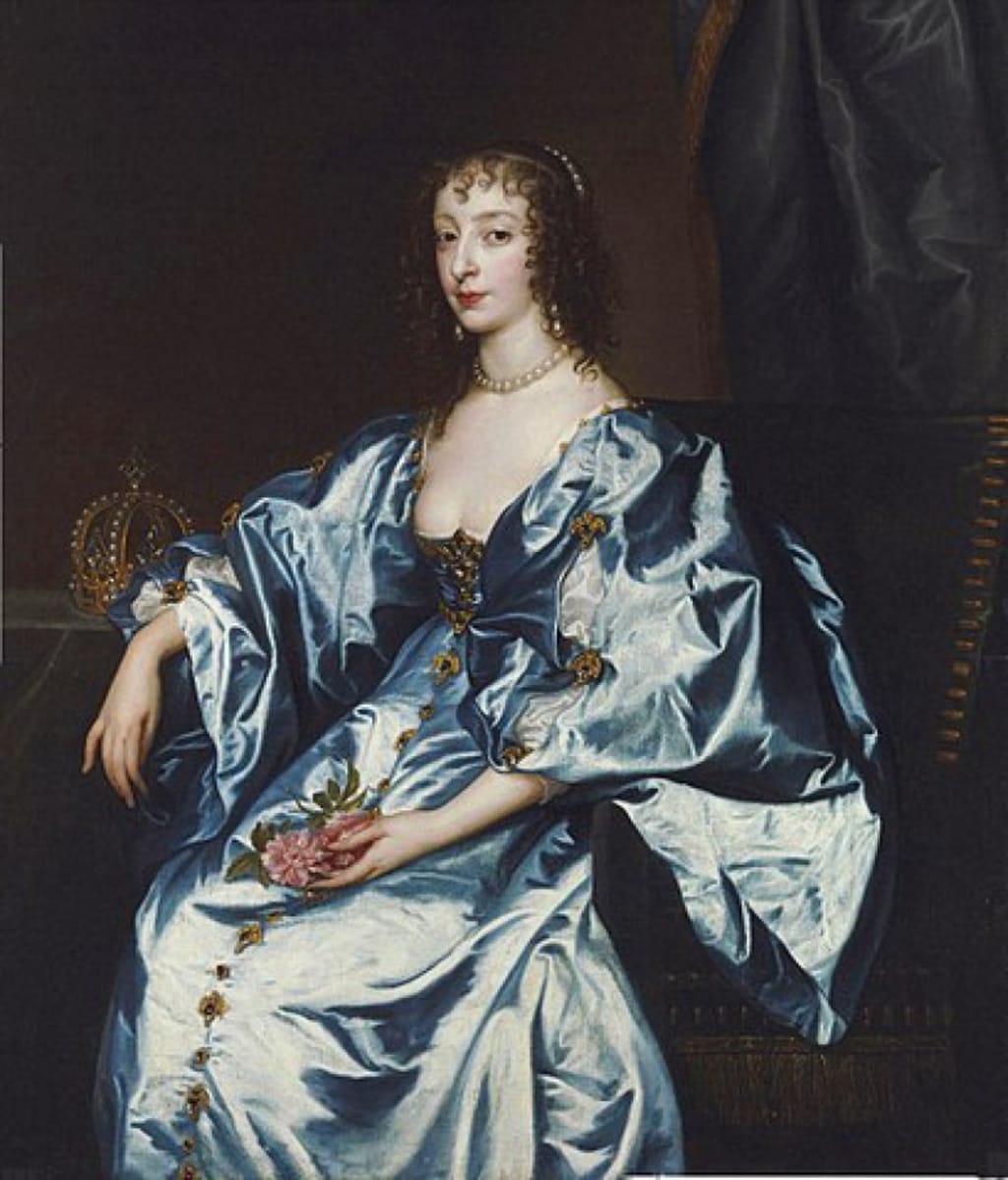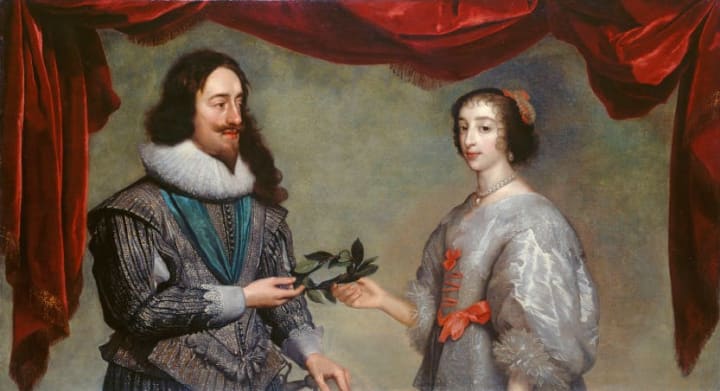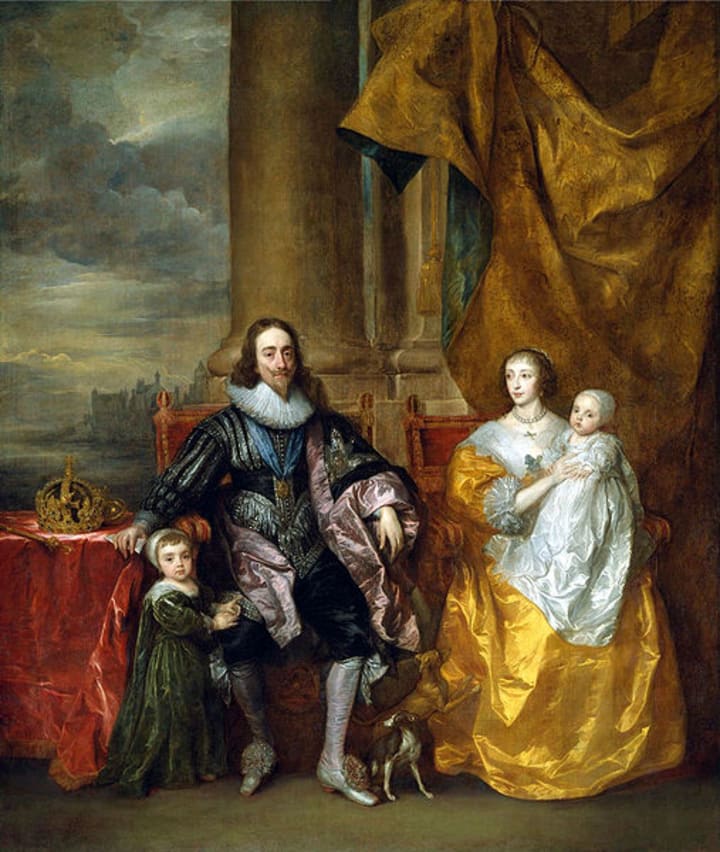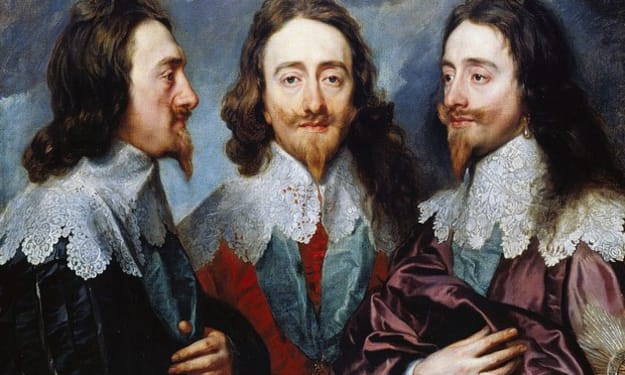Henrietta Maria
"She displayed courage and determination in mustering support for the King's cause"

Henrietta Maria was a beautiful 15 year old Princess who married a much older Prince. Moving to a new country, she had to learn a new language, a new way of life and practised her faith amongst ‘infidels.’ This Queen showed courage, as well as intelligence, during a very difficult period within the English history.
The youngest daughter of Henry IV of France and Marie de’ Medici, Henrietta Maria was named after her parents. She was born on 25th November, 1609, at the Palais du Louvre. As a daughter of the Bourbon King of France, Henrietta Maria was a Fille de France, a member of the House of Bourbon and she was brought up a Catholic. Her older brother was the future Louis XIII of France. When this little Princess was less than one year old, her father was assassinated on 14th May, 1610. Her governess was Francoise de Montglat. Along with her sisters, Henrietta Maria was tutored in reading and writing, and was trained in riding, dancing and singing, and was ‘heavily influenced’ by the Carmelites (a Roman Catholic religious order of men and women). Her mother was banished from Paris when Henrietta Maria was 7 years old.
By 1622, this French Princess was living in Paris with a household of some 200 staff, and now marriage plans were being discussed. At 15 years of age, Henrietta Maria married Charles I by “proxy” (“this was a wedding in which one or both of the individuals being united are not physically present, usually being represented instead by other persons”). This may have been because of the bride’s young age but nothing more is recorded. The proxy marriage took place at Notre-Dame de Paris on 1st May, 1625. The newly-weds spent their first night together at St. Augustine’s Abbey (near Canterbury) on 13th June, 1625.To us today, the bride’s young age, 15 years old, is unacceptable to get married but back then, it was quite normal for young Princesses to marry at such a young age.
Henrietta Maria refused to participate in the Church of England ceremony when her new husband, Charles I, was crowned in Westminster Abbey, on 2nd February, 1625, as she was a Roman Catholic. This did not go down well with the English people who were suspicious of Roman Catholic Queens (Mary I comes to mind, who was called “Bloody Mary” because of all of the Protestants she had executed). In the beginning of the marriage, Henrietta Maria was treated with “insolence” by the Duke of Buckingham, who may have been jealous of Charles’ new wife, and this caused quite a strain on the relationship between the newly-weds. However, when the Duke was assassinated, “Charles fell in love with his wife,” who was now a patron of drama and presided over a lively Court.

The new, young Queen came to England with a huge quantity of expensive possessions --- jewellery, ornate clothes, 10,000 livres worth of plate, chandeliers, pictures and books. When you think that the only means of travel between France and England was by boat in that Century, it is a miracle that so much came over undamaged. She was accompanied by a large ‘retinue’, which included her ladies-in-waiting, 12 Oratorian priests and her pages --- all of which were costly. Charles blamed these people for the ‘strain’ that was on his marriage and had them physically ejected from Court. However, Henrietta Maria did manage to keep her chaplain and confessor, Robert Phillip, and 7 of her French staff. The removal was also part of a plan to ‘control’ the Queen’s extravagant expenditure. Jean Caille was appointed as her treasurer, who was succeeded by George Carew and, in time, by Sir Richard Wynn.
Over the next few years, Henrietta Maria, or “Maria” as Charles liked to call his young wife, had a new household begin to form around the young Queen. Henry Jermyn became her vice-chamberlain in 1628 (and Maria’s favourite). The Countess of Denbigh became the Queen’s Head of the Robes (and confidante). Maria acquired several dwarves, including “little Sara”, and she ‘established her presence’ at Somerset House, Greenwich Palace, Oatlands, Nonsuch Palace, Richmond Palace and Holdenby. These were part of the Queen’s jointure lands. She added to these Wimbledon House, which was a gift from her husband and Maria also loved her animals, having a menagerie of dogs, monkeys and caged birds.
As mentioned before, the King and Queen became close after the Duke of Buckingham’s death and the two forged deep bonds of love and affection. Maria became pregnant in 1628, but being the first baby, the labour was difficult and the baby died shortly after being born in 1629. The next baby was born in 1630, the future Charles II, after a ‘complicated childbirth’ according to the physician Theodore de Mayerne.

Like her husband, Maria was very interested in the arts, and her ‘patronage’ of various activities was one of the ways in which she tried to shape Court events. However, because of her strong views on religion, Maria became a “highly unpopular Queen who apparently never successfully commanded intense personal respect and loyalty from most of her subjects.” (1642) When the Civil War became close, Henrietta Maria moved to Hague, for her own safety and to raise funds for Charles’ cause as Hague was a major center for banking and finance. Returning to England in 1643, the Queen tried to raise the Royalist cause in the North, but the Royalist position had deteriorated and she fled to France the next year (1644). Henrietta Maria never saw Charles again. King Charles I was executed in 1649 and this left Maria almost destitute and in shock.
Henrietta Maria now focused her life on her faith and her children, Henrietta, James and Henry. Her oldest son Charles (later Charles II) had taken up Court in Cologne, not wanting to be influenced by his mother. Only her daughter, whom she called “Minette”, was brought up a Catholic. Maria also founded a convent at Chaillot in 1651, and lived there for much of the 1650’s. After the Restoration, she did return to England, and was granted a pension of £60,000 a year, but could not settle and finally went home to France in 1665.
Henrietta Maria died at the Chateau de Colombes, having taken an excessive quantity of opiates as a painkiller --- on the advice of Louis XIV’s doctor on 10th September, 1669, aged 59 years of age. Maria was buried on 13th September, 1669, at the Royal Basilica of Saint Denis.

Henrietta Maria’s life showed me the courage of a 15 year old young ‘woman’, living in a new country, trying to learn a new language and being married to a much older man. During her life, “Maria” tried to find happiness in her husband and then her children, eventually finding peace in her faith after the horror of the beheading of her King and husband.
(Research = Wikipedia and Britannica)
About the Creator
Ruth Elizabeth Stiff
I love all things Earthy and Self-Help
History is one of my favourite subjects and I love to write short fiction
Research is so interesting for me too






Comments
There are no comments for this story
Be the first to respond and start the conversation.